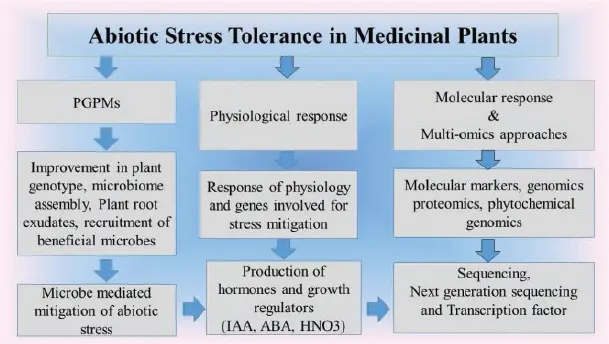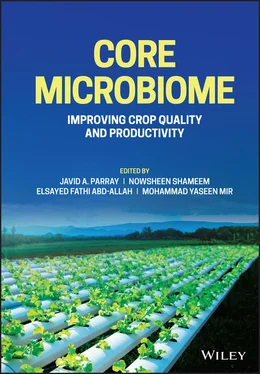3.3 Physiological and Molecular Response of Plant and Microbiota against Stress
Salinity reduces mineral nutrients transport into the plants that retard growth and yield of medicinal plant as well as their active components. Some studies showed that the composition of essential oil of marjoram ( Origanum majorana ), coriander ( Coriandrum sativum ), and peppermint ( Mentha piperita ) have changed due to these stresses. Moreover, salinity and sodicity affect shoots and root yield of citronella, lemongrass, and vetiver plants (Naeem et al. 2013). Seed germination showed a significant reduction at 200 mM NaCl stress in Thymus maroccanus (Belaqziz et al. 2009), sweet marjoram (Ali et al. 2007), Ocimum basilicum (Miceli et al. 2003), and Ocimum (Chowdhary et al. 2018). Moreover, seedling growth has also been affected in Thymus maroccanus (Belaqziz et al. 2009), basil (Ramin 2006), marjoram , and chamomile under salt stress (Ali et al. 2007). Salt stress has affected the transport of reserved foods, reduced cell division, and increased hypocotyls (Said-Al Ahl and Omer 2011). The growth characteristics such as leaf area, the number of leaves, and accumulation of biomass have been reduced in a variety of medicinal plants. Defense mechanisms adopted by plants toward abiotic stresses are presented in Figure 3.1. However, salt stress also has effects on geranium (El-Leithy et al. 2010) and sage (Ben Taarit et al. 2009). High salinity at 200 mM NaCl concentration was responsible for the increase in ascorbic acid contents while glutathione contents were reduced at 25 mM salinity level in Catharanthus roseus (L.) (Jaleel et al. 2008). Enzymatic activity such as SOD activity was increased at 50 mM NaCl, while it was decreased at a higher 200 mM level. Moreover, peroxidase activity at 25 mM NaCl was insignificant while it was significant at 50 mM salinity level (Jaleel et al. 2008). Drought affects the morphology, physiology, and biochemistry of medicinal plants, resulting in a significant loss in yield, though the effects of drought on many crop plants were investigated while little was reported about the biosynthesis and accumulation of oil in medicinal plants under drought conditions (Farahani et al. 2009). Drought at the vegetative stage reduced plant height and leaf area of mint (Abbaszadeh et al. 2009). Furthermore, Calendula plants use less water due to reduction in plant height (Rahmani et al. 2011) while dry matter reduced at the vegetative stage was recorded in balm. The oil quality of rosemary ( Rosmarinus officinalis L.) is affected due to drought while thyme oil production increases (Aziz et al. 2008). Medicinal plants such as Catharanthus roseus cultivation under drought enhances its proline metabolism, osmoregulation, and defense system (Jaleel et al. 2008). Drought stress response depends on cultivar and plant density in medicinal plants. Proper amount of nutrients might increase resistance against stress and improve productivity when crops are subject to drought stress (Cakmak 2005).

Figure 3.1 Diverse abiotic stresses and their response toward medicinal plants and the defense mechanisms adopted by plants.
Another type of stress called heat shock, which is normally brought on by an increase by 10–15°C above ambient temperature also influences plant growth and metabolism. On the other hand, the highest photosynthetic rate was determined at 30°C. Besides other symptoms, the prominent symptoms are inhibition in photosynthesis at high-temperature stress (Camejo et al. 2005). Temperature stress also affects several changes at the cellular level and metabolism. High and low temperatures incite the biochemical and physiological changes in plants. These stresses lead to lipid peroxidation and membrane disruption. Moreover, chlorophyll and protein degradation were also recorded due to high-temperature stress. High-temperature stress showed a negative effect on photosynthesis as well as reduced various enzyme activities in rice (Mohammad and Tarpley 2009). Moreover, RUBISCO activity was also reduced due to the inhibition of photosynthetic activity in Festuca arundinacea under high-temperature stress. High-temperature stress ranges between 25°C and 40°C encouraged not only the activities of reactive oxidative species (ROS) scavenging enzymes but also increased the activity of lipoxygenase and the content of 3,4-methylenedioxyamphetamine (MDA) and cysteine as well as that of protein and non-protein thiol in the leaf and root of Phalaenopsis (Ali et al. 2005). Low temperature also acts as a growth-limiting factor to limit the productivity and distribution of crop plants. When a plant is subjected to low temperature, ROS produced repeatedly and may disrupt normal metabolism through oxidative damage to lipids, nucleic acid, and protein. Low-temperature stress affects the physiological and biochemical characteristics of Crofton weed ( Eupatorium adenophorum ) (Ma et al. 2020). As a result, MDA, total soluble protein contents, soluble sugar, chlorophyll changes, and fluctuation in SOD activity increase (Li et al. 2008). Exposure of sweet potato ( Ipomoea batatas L.) to chilling stress reduced transpiration rate and stomatal conductance while enhancing peroxidase activity and electrolyte leakage (Islam et al. 2009).
3.3.1 Effect of Plant Genotype on Rhizosphere Microbiome Assembly
A large number of bacteria associated with the rhizosphere of plants produce phyto-therapeutic compounds that increase the growth of medicinal plants. Rhizosphere microbes of Matricaria chamomilla L., and Calendula officinalis L growing naturally in desert ecosystem showed abundant occurrence of bacteria (gram positive), which is very important for pathogens suppression. A large difference in endophytic bacterial diversity in medicinal plants, i.e., Lamiophlomis rotate , Codonopsis pilosula , and Ephedra sinica was recorded by Li et al. (2008). In contrast, different varieties of microbial groups are present in the soil. About 50 strains of 47 genera Stigmatella (1), Archangium (8), Myxococcus (18), Corallococcus (11), Cystobacter (7), Pyxidicoccus (1), with dominant genera of Corallococcus and Myxococcus . The incessant cropping of Rahmannia glutinossa decreases the productivity of some medicinal plants due to plant–microbe interaction activity in the rhizosphere (Qi et al. 2009). Different medicinal plant–microbe interactions in the rhizosphere is presented in Table 3.2.
Table 3.2 Rhizosphere Microbes Interactions in Medicinal Plants.
| Plant species |
Microorganism |
References |
| Angelica sinensis |
Terriglobus saanensis , Mucilaginibacter polysacchareus , Mucilaginibacter myungsuensis, Mucilaginibacter ximonensis |
Whang et al. (2014) |
| Matricaria chamomilla , Calendula officinal, Solanum distichum |
Bacillus sp. |
Koeberl et al. (2013) |
| Rumex patientia |
Proteobacterium Bacteroidetes , Acidobacteria, Gemmatimonadetes, Verrucomicrobia, Planctomycetes, Actinobacteria , Firmicutes , Chloroflexi |
Qi et al. (2012) |
| Atractylodes lancea |
Gram-negative bacteria |
Dai et al. (2013) |
| Origanum vulgare |
Pseudomonas, Stenotrophomonas |
Bafana (2013) |
| Typhonium giganteum |
Kribbella flavida, Kribbella karoonensis, Kribbella alba |
Xu et al. (2012) |
| Ginseng plants |
Actinomycetes |
Zhang et al. (2013) |
| Ajuga bracteosa |
Pseudomonas |
Kumar et al. (2012) |
| Nerium indicum |
Pontibacter |
Kumar et al. (2012) |
| Nerium indicum |
Pontibacter |
Raichand et al. (2011) |
| Fritillaria thunbergii |
Proteobacteria Acidobacteria Actinobacteria Bacteroidetes |
Shi et al. (2011) |
| Astragalus membranaceus |
Geodermatophilus obscurus |
Zhang et al. (2011) |
| Phytolacca acinose |
Aspergillus fumigatus |
Guo et al. (2010) |
| Agathosma betulina |
Cryptococcus laurentii |
Cloete et al. (2010) |
| Ocimum sanctum, Coleus forskohlii, Catharanthus roseus, Aloe vera |
Azospirillum, Azotobacter, Pseudomonas |
Karthikeyan et al. (2008) |
| Annona squamosa , Eclipta alba , Cassia auriculata |
Bacillus, Pseudomonas, Enterobacter, Corynebacterium, Micrococcus, Serratia |
Tamilarasi et al. (2008) |
3.4 Microbe-Mediated Mitigation of Abiotic Stresses
Читать дальше












